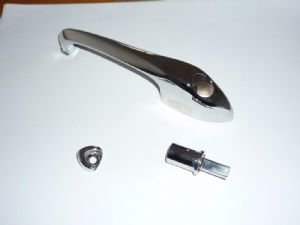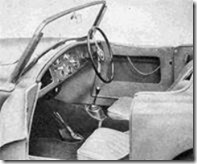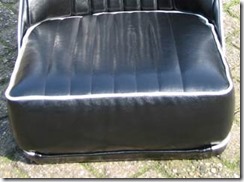Category Archives: 07. Body
Special fuel filler position Turner 950 Sports
Introduction
The standard position for the fuel filler for the Turner 950 Sports Mk1 is inside the boot (trunk). The standard Austin A35 fuel tank has been slightly modified, changing the angle of filler pipe in the direction of the centre of the car to have better access to the filler cap with the boot lid open. The risk of spilling some petrol inside the boot is of course present. But another disadvantage was more important for Turners used in racing especially when entering a long distance event (like a Six-hour race): it takes too much time to open the boot lid!
 208JJH at Brands Hatch in October 1960
208JJH at Brands Hatch in October 1960
My Alexander-Turner 950 Mk1 (60-307) therefore had the filler opening repositioned to the outside of the car, just to the right of the boot lid. This has (apparently) been done in the Alexander work shop as this car had the modification from the beginning (March 1960). The above photo taken at Brands Hatch (October 16, 1960) clearly shows that the petrol filler has been moved.
 Rear body of 60-307 with original position of external fuel filler still visible
Rear body of 60-307 with original position of external fuel filler still visible
During the restoration of 208JJH I noticed that there used to be a hole in this area that had been closed again with GRP and I thought this could have been a later modification that had been dropped again. On basis of the above photo it is clear that this was the original hole and I recently decided that the car should receive the (original) fuel filler position again.
Modification
The standard pipe connection and hose have a 2¼“ (57 mm) diameter. For the modification we require either a very flexible 2¼“ fuel hose or some pieces of metal pipe of the same diameter bended 45⁰, and some pieces of 2¼“ rubber hose to connect these pipes. Because the standard filler pipe has 30⁰ angle in the opposite direction of where the new filler opening will be positioned, some sharp bends will have to be made in order to have the filler pipe and filler cap positioned in an angle perpendicular to the sloping body at the right side of the boot lid.
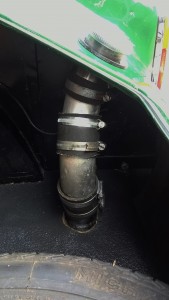 New filler pipe construction
New filler pipe construction
The photo shows the construction of the filler pipe as described, using the original 2¼“ filler cap construction. Found a grommet with an inner diameter of 2¼“ (57mm) suitable for a panel hole of 2¾”or 70mm (grommet for a VW T25 bus used from May 1979 till July 1983). It fitted beautifully in the 70mm hole drilled in the GRP panel.
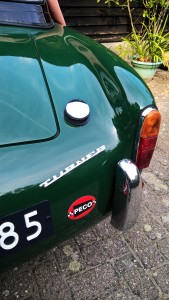 Final result; compare with original photo.
Final result; compare with original photo.
The end result is very pleasing and fully in line with the original photo from 1960.
Turner 950 Mk 1 Door Locks
Turner Mk 1 door locks
The Turner Mk 1 uses door locks from various “Standard” car types. The brand “Standard-Triumph” later continued as Triumph. A complete door locking systems consists of the following parts (see Plate J in the Service Parts List):
- Part J 4 Door handle (2x)
- Part J 8 Door Lock LH
- Part J 8A Door Lock RH
- Part J 9 Door striker LH
- Part J 9A Door striker RH
- Part J 10 Dovetail Male (2x)
- Part J 11 Dovetail Female (2x)
Part J 4 Door handle (2x)
The handles are made by Wilmot Breeden and used on the Standard 8 and 10, Pennant and Companion, Vanguard IA and Vanguard II. There are versions with and without a locking barrel. Turner used only the version without a locking barrel. The end of the barrel has an adjustable rod that activates the door lock.
Part J 8 and J 8A Door locks for Turner 950 Mk 1
Turner used inner door locks from the Standard Ten. These were made by Wilmot Breeden. Part No’s on lock mechanism:
- 3’ 10574-5-6-7 LH 3’ 8591-2
- 3’ 10574-7 RH 3’ 9370-1
 Compare door lock construction from Standard Super 8
Compare door lock construction from Standard Super 8
Part J 9 and J 9A Door strikers
The door striker is a pin on a bracket (LH and RH versions) that slides into the door lock. Part Nº unknown. To adjust the position of the striker in relation to the door lock (also to compensate dimensional variation in door-manufacturing) spacers are available in various thicknesses.

 Door strikers LH and RH
Door strikers LH and RH
The pin of the striker is about ¾” (19 to 20 mm) long (measured from its baseplate without any spacers placed). The pin of the striker has a “tough life” and is often damaged. The pin has a triangular shape, but it can be repaired using a steel rod of about ⅜” (9 to 10 mm) in diameter welded to the (remains of) the original pin.
 Door striker spacer
Door striker spacer
Part J 10 Dovetail Male (2x)
The male part is mounted in the door opening. Part Nº unknown
Part J 11 Dovetail Female (2x)
The female part is mounted inside the door of the Turner and receives the Male Dovetail part J 10. It guides the door into the correct position. Part Nº unknown.
Turner 950 Sports bucket seats
Turner 950 Sports bucket seats (period 1957 – 1963).
Renovated seats using the original GRP buckets
Seat pictures from contemporary road tests.
Turner 950 seats in detail
The lightweight Turner seat is constructed from a Glass-fibre Reinforced Polyester bucket shell with integrated backrest. The cushion can be removed, giving access to the seat mounting bolts.
The seats can be restored. The GRP bucket shell should be checked for cracks and repaired where needed. The old covers can be used as a pattern or read the description further on. New foam (of a higher density) is required for the cushions.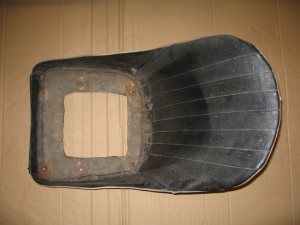 GRP bucket shell
GRP bucket shell
 Front of the seat covered in vinyde
Front of the seat covered in vinyde
The backrest cover is made of black vinyde with white piping. It has 6 flutes (6 x 43⅓ = 260 mm) and side pieces, all filled with white cotton. Between the cover and the GRP the backrest is filled with cotton padding to give better support and some form of “comfort” (see photo).
Seat cushion has 6 flutes (6 x 43⅓ = 260 mm) and 2 x 75 mm flutes at both sides. White piping around cushion.
Triplex Glass Manufacturing Date Codes
Triplex Glass Date Codes (prior to Jan 1969)
Cars made in the 1950’s to the late 1970’s can be dated by the ‘TRIPLEX CODE’ etched into the toughened glass. Note that it dates the GLASS, so is only an indication of the cars age, assuming the glass is original.
Year code
The year code can be found in the Nine letters make the word TOUGHENED. One dot below a letter gives the year of the decade:
T O U G H E N E D
- T = 1
- O = 2
- U = 3
- G = 4
- H = 5
- E = 6
- N = 7
- E = 8
- D = 9
- No dot = 0 (or possibly a dot under a space after the last letter)
This code also works if you have a TRIPLEX curved windscreen with the (also Nine letter) word LAMINATED instead of TOUGHENED.
Quarter code
To further determine the approximate month of production, just look for two dots in the TRIPLEX logo on the glass.
T R I P L E X
One dot above T, R, E, or X gives the quarter of the year the glass was manufactured:
- T = Jan, Feb, March,
- R = April, May, June,
- E = July Aug, Sept,
- X = Oct, Nov, Dec.
Example: say your car is from the 50’s, then TRIPLEX TOUGHENED, with one dot over the ‘R’ in Triplex, and the other under the last ‘E’ in Toughened, indicates ‘April/May/June 1958’
Date code 2nd quarter 1959 Older example from the 30’s.
Triplex branded Glass (after Jan 1969)
The year indication is still identical to the TOUGHENED or LAMINATED system, but the month code changed. The month of manufacture is now indicated by the dots over the word TRIPLEX:
August 75 Later logo with unknown Date Code system
History of UK Glass Manufacturers for the Automotive Industry .
British Indestructo Glass Ltd (to be investigated)
Pilkington (now owned by Nippon Sheet Glass Co., Ltd).
In 1929 Pilkington and Triplex formed a joint company to build a works at Eccleston, St. Helens. Pilkington gradually increased its shareholding in Triplex until by 1965 it became the majority shareholder.
In Pilkington’s Queenborough factory on the Isle of Sheppey in Kent the original glass products were made under various brand names like Triplex, Sigla, Bilglas or SIV. Today they can still supply products with the original trademark. The Queenborough factory has made classic windscreens for the aftermarket since the late 1950s, and still retains the vast majority of the tooling produced ’’in-house’’. The range consists of over 2000 parts including, AC Ace, 1953/63, Mercedes 220 1961/71, Aston Martin DB 4 1958/65 and MG’s to name a few. The specialist factory is certified according to BS EN ISO 9001: 2000 ensuring that all legal requirements are met.
Triplex Safety Glass Co. Ltd. (Est. 1922).
Hythe Road, Willesden, London, N.W.10. “TripleX” laminated and toughened safety glass, both plate and sheet, Multi-ply and bullet-proof glass, Curved safety glass, Shaping, forming and manipulation of “Perspex” and other thermoplastic materials. Trade names: TripleX, Triplite, TriFlex.
 Tudor Safety Glass advertisement, 1956.
Tudor Safety Glass advertisement, 1956.
Tudor Safety Glass Co. Ltd. (Estd. 1935).
Spring Place, Kentish Town, London, N.W.5. Two toughening, ten bending furnaces: electricity, gas. Laminated and toughened safety glass, machinery glassware. Trade name: Vinylex. Tudor has been taken over by Triplex Safety Glass some decades ago and thus belongs to the Pilkington Group of companies.

